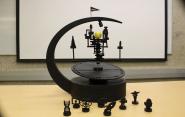ENAS 118: Tennis, Art, Museums, and More

From labs to the Peabody Museum to the tennis courts to CCAM, the students in Engineering Innovation & Design (ENAS 118) applied their problem-solving skills throughout the campus this past semester. Taught by SEAS senior research scientist Larry Wilen and SEAS Deputy Dean Vince Wilczynski, the course tapped the expertise of faculty and staff from numerous disciplines throughout Yale.
For each of these projects, the student teams worked with their clients - people who encounter these issues regularly and simply want a better way to tackle them. Most of the work took place in the John Klingenstein '50 Design Lab at the Center for Engineering Innovation & Design (CEID), but the students also took field trips to the sites of their projects.
- So you want to practice your tennis serve, but are never sure if you’re hitting your target? Ximena Leyva '25, Miriam Viazmenski '25, and Boris Katafygiotis '25 are there for you. Working with Yale tennis coach Christopher Drake, they developed SERTA, a light-up target for tennis serves that borrows technology from blood pressure cuffs. Existing targets tend to be heavy, makeshift boards. Besides being unwieldy, they don’t alleviate the tedium that can set in during long sessions. On the other hand, SERTA, a mat that’s placed at the side of the target, is lightweight, durable, and fun. When the ball hits the mat, air inside is pushed and triggers a pressure sensor, which then sends the data to an Arduino. The results are then displayed on an LED strip.
- To protect its exhibits, the specifications of a museum’s environment needs to be maintained at all times. The team of Jacob Lessing '25, Urszula Solarz '25, J.P. Fernandes '25, Cam Greene '24, and Annika Bryant '25 worked with the Peabody to create a system that allows administrators to monitor the environment of a space remotely. The system monitors long-term levels of heat, humidity, visible light, and UV radiation inside exhibit cases. Current systems are costly, require a fair amount of work to operate, and retrieving data isn’t always easy. The student team developed a system that can be made for minimal costs, runs continuously for at least six months, and reports data in real time to the curator’s smartphone. Also, the sensors inside the case are well-hidden.
- The student team of Cecilia Russell '25, Henry Kaplan '25, Max Werner '25, and Paula Toranzo Paredes '25 developed a microplant treatment system for the lab of Joshua Gendron, associate professor of molecular, cellular & developmental biology. Gendron needed a system to help him monitor the circadian rhythm of microplants (plants in their first stages of growth), which includes treating them with luciferin to make them bioluminescent for imaging. The team had the task of creating a system that supplies and removes all the necessary chemicals for the seedlings with minimal disruption to the imaging process. They achieved this by creating Flowra, a system that pumps the chemical solution into the imaging chamber and into a flow chamber, and then into an outflow. An overflow chamber catches excess liquid.
- For the meticulous athletes who don’t just lift a lot of weight, but want to know how fast they’re doing so, Ben Phifer '25, Peter Messina '25, Michelle Luh '25, and Elyse Nguyen '25 worked with Yale’s director of sports performance and student athlete innovation T.J. Belanger. Existing systems for this are not only expensive, but they’re not always accurate and can have a low battery life. The team created the Velocirepper, a device outfitted with a time-of-flight sensor that measures the distance of the rep and the time it takes to complete that rep. A buzzer and display guides the user through the process and lets you know if you’ve hit your target reps and speed.
- Horse Island, the largest of the Thimble Islands off the coast of Branford, CT, has been used by Yale researchers to study wildlife. Working with the Yale Peabody Museum’s assistant director of student programs Nicole Palffy-Muhoray, the student team of Jin Wuk Lee '25 and Sofia Rabbani '25 were given the assignment of creating a humane trap that holds an animal for the least amount of time possible. They created a device that allows users to remotely identify the species, and remotely release the animals. The trap is outfitted with a camera that when tripped, takes a photo of the animal and automatically emails the image. The user can then request more pictures, or order the trap to release the animal.
- Dona Elkwalla '25, Pia Dukaric '25, Jonah Heiser '25, and Sena Sugiono '25 worked with Dana Karwas, director of Yale’s Center for Collaborative Arts and Media (CCAM) to create a device that combines both engineering and art. The team created a mechanical model of the solar system, known as an orrery. Not only did the team have to devise a system in which the different arms and gears moved at the right speeds and in sync with each other, the sculpture had to represent the many different aspects of CCAM. The students noted that coordinating the aesthetics with the technical components of the project was the trickiest part. Karwas said the end result will be placed in the CCAM gallery, “as a way to explain what we do at CCAM.”

